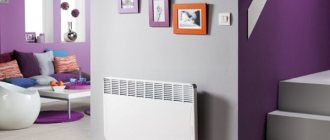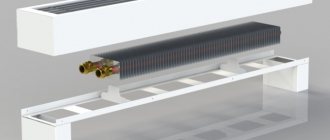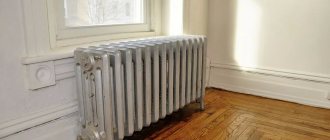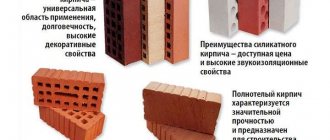An electric convector with a thermostat is a heating equipment that maintains a given temperature in the house. The built-in electronic thermostat allows you to precisely regulate the heat with a deviation of 0.1-0.30C. Thanks to its beautiful design, safety and efficiency, a modern convector with an electronic thermostat deserves the attention of the consumer.
Varieties
Among the main types of convectors with an electronic thermostat, the following devices are distinguished:
- Wall-mounted. The most common type of heating equipment. When using this technique, warm air accumulates at the top and cold air at the bottom. With high ceilings, uneven distribution of air flow will be a significant disadvantage.
- Floor-standing. Mobile equipment is used as an auxiliary heating device.
- In-floor. Convectors of this type are designed for use in office and residential premises where strong noise or design solutions prevent the use of devices with forced convection. The equipment is perfectly compatible with underfloor heating systems. In-floor electric convectors are made with corner connections, arc-shaped, wave-shaped, with a roller or linear grid. The heating duct comes in different sizes and is made of granite, marble, wood. Disadvantages include the high price and complex installation of the device.
Trench electric convectors
Advantages and disadvantages
One of its main advantages is the method of attachment. It is convenient and optimal to mount a heating device on the wall, which will not only save space, but also heat the room faster.
In addition, when purchasing a convector of any type, you can immediately put it into operation. You do not have to participate in or pay for the creation of grandiose heating system projects.
And the most important advantage is the speed of heating the room. Any other heating devices will not cope with this task so quickly.
Among the disadvantages it is worth considering the following:
- the device must be located near an electrical network (socket);
- high electrical energy consumption.
Device Features
The structure of the electric convector will differ depending on the type of heating equipment. The design of a wall-mounted electric heater consists of the following components:
- device body;
- heating element (heating element);
- off/on buttons;
- cord with plug;
- thermostat;
- grille with guide curtains for air outlet;
- thermal fuse that protects against overheating;
- tilt sensors and protection against foreign object penetration (additional options that depend on the model).
The design of the electric heater built into the floor is somewhat different and includes:
- decorative frame profile;
- roll-type grille made of anodized aluminum;
- high-performance convector;
- EC fan;
- protection against twisting in the wire connection unit;
- mounting feet for height adjustment.
Note! Convectors with an electronic thermostat are designed to heat residential premises with an optimal level of humidity. Do not use the device in swimming pools. Models with appropriate protection are marked IP24.
Ballu BEC EVU-1500
Next in the review is the convector Ballu BEC EVU-1500. The unique shape of the convector body with a wide base and a smooth narrowing in the upper part allows you to increase the speed of convection and, as a result, increase the efficiency of heating the room. In the event of an unplanned power outage, the Auto Restart function allows you to automatically turn on the device while maintaining the settings in effect at the time of the shutdown.
Distinctive features of the convector: a new generation monolithic heating element Double G Force, an innovative system of uniform convection Homogeneous flow, an air intake with an increased area of Intake, a new technology in fastening the heating element Thermoresist compact, splashproof design IP24.
The convector with an aerodynamic body is equipped with overheating and tip-over protection sensors. Feet with wheels are provided for floor installation and easy movement. There is a full and half power mode. The convector is easy to operate.
The device is installed on a flat, dry surface. The heater should only be used in assembled form.
- type - convector;
- maximum heating area 20 sq.m;
- heating power 1500 W;
- number of operating modes - 2;
- overheat shutdown, moisture protection;
- mounting - wall;
- type of heating element - monolithic;
- dimensions - 56×40.40×9.10 cm;
- weight - 3.2 kg.
Principle of operation
electronically controlled convector is based on the circulation of air masses at different temperatures. Inside the device there is a heating element, on the surface of which there are holes. Thanks to the lower compartments, cool air flows freely into the device and is heated by the heating element. Afterwards, the heated masses rise and exit back through the blinds at the end of the convector.
The heating element in the technique is a tubular heating element, which is made of a special alloy. The material is heated to a certain temperature, and after a while the room becomes warm.
The principle of natural convection allows for high efficiency of heaters of this type - from 90% and above. This means that electricity is used sparingly without a large percentage of heat loss, going only to heating the air.
Operating principle of the convector
The best electric convectors for areas up to 15 sq.m.
This subcategory includes low-power electrical appliances of 1000 - 1500 W. They are distinguished by their compact size, simple controls, quiet operation, and low cost (depending on the model). As a rule, such heaters are installed on the floor and can be moved freely around the room. They are purchased for small residential premises or garages. During operation they consume a minimum of electricity.
6 Edison Polo 1500M
Our rating opens with an electric convector from Edison.
The Polo 1500M model is designed to heat a medium-sized room. The heating device is distinguished by its modern design, reliability, high efficiency and safe operation. The maximum power of the device is 1500 W, and you can also set one of two modes: 600 W and 900 W. The convector can be placed on the floor (on legs) or mounted on the wall.
To ensure safety, there is a thermal switch that automatically protects the device from overheating. The Polo 1500M model uses a needle type heating element. The desired temperature regime is set using a mechanical regulator. The compact device takes up little space and weighs no more than 1.4 kg.
Buyers prefer the Edisson Polo 1500M convector due to its compactness, simple mechanical controls, fast heating, and neat assembly.
Pros:
- Affordable price.
- Nice design.
- Lightweight, comfortable, compact.
- Heats the air quickly.
- Mechanical control.
- Safety system.
Minuses:
- Short wire.
Edison Polo 1500M
5 Hyundai H-HV16-10-UI620
The fifth position is occupied by the Hyundai H-HV16-10-UI620 convector, which can create comfort in your home or country house with the onset of cold weather.
Modern design and classic white color allow the device to fit into the interior. And the presence of a well-designed grille ensures uniform distribution of warm air in the room. The compact device weighs 3 kg and has a power of 1000 W; it is capable of heating a room of no more than 13 sq.m. At the same time, using the rotary switch you can adjust the power and select a value of 500 W. The monolithic heating element quickly reaches the required temperature, and the built-in copper alloy thermostat maintains it at the desired level during operation of the convector.
The equipment can be installed on the floor on legs or hung on the wall. The overheating protection system will automatically stop the operation of the convector to avoid its breakdown. Users choose this electric heater for its good combination of price and quality, compact size and thoughtful design.
Pros:
- Inexpensive, compact, lightweight.
- Warms the air quickly.
- Distributes heat evenly.
- Thermostat.
- Overheat protection.
Minuses:
- No carrying handle.
Hyundai H-HV16-10-UI620
4 Ballu Camino Eco Turbo BEC/EMT-1000
In fourth place is the Ballu Camino Eco Turbo BEC/EMT-1000 heater, with heat transfer increased by 20% due to the larger area of the monolithic heating element.
Produced in Russia. The convector is a compact device designed for a room of 15 sq.m. The model is floor mounted with a stable stand. The device is controlled mechanically; its operation is indicated by an LED indicator. The maximum power of the heater is 1000 W, this indicator can be adjusted.
The Ballu Camino Eco Turbo BEC/EMT-1000 model guarantees high operational safety thanks to the built-in functions:
- Auto Restart - automatically turns off the device during power outages, preserving all current settings.
- Overheat protection.
- Auto shut off when tipped over.
Thanks to its compact size, affordable price and simple controls, this convector is popular among buyers who choose it for heating small rooms at home and in the country.
Pros:
- Compact, lightweight, convenient.
- Simple controls.
- Heats the air quickly.
- Quiet.
Minuses:
- No wall mount.
Ballu Camino Eco Turbo BEC/EMT-1000
3 Xiaomi SmartMi Electric Heater 1S (DNQZNB05ZM)
The third place in our rating is occupied by a “smart” electric convector from Xiaomi, designed for small spaces.
Power consumption 2200 W. The device does not have a fan in its design; cold air enters it from below, then warms up by natural convection and exits through the top. Thus, the air in the environment does not dry out, its temperature is maintained in the range of 16-28 °C. You can control the device remotely using Wi-Fi technology.
The SmartMi Electric Heater 1S (DNQZNB05ZM) model can be used to heat a bathroom; it is not afraid of high humidity and accidental splashes. The device is also protected from overheating and tipping over. When heated above 95°C and tilted at an angle of 45°, it automatically turns off.
The device is controlled using a touch display, which has three brightness modes. The weight of the device does not exceed 6 kg, the side handles make it easy to transport it around the apartment.
Users choose this model of electric convector for their home due to its stylish design, high-quality assembly, simple operation, high performance and safety of use.
Pros:
- Trusted brand.
- High quality.
- Modern design.
- Safety of use.
- Remote control.
Xiaomi SmartMi Electric Heater 1S (DNQZNB05ZM)
2 Electrolux ECH/AS-1000 MR
The second place is occupied by an electric convector from Electrolux, which has a stylish design and is designed to create comfort in a room up to 15 sq.m.
The ECH/AS-1000 MR model is equipped with wheels for easy transportation around the room. They can be removed and easily mounted on the wall. The design of the equipment involves an X-shaped heating element and the presence of a thermostat that allows you to maintain a constant heating temperature.
The convector power is 1000 W, you can also set the mode to 500 W. Comfortable control is provided by a mechanical switch with LED backlight. In case of overturning, overheating, freezing, or splashing water, it turns off automatically.
The electric device quickly warms up small rooms, it is compact, lightweight, has mechanical control and a choice of power mode. Therefore, many buyers preferred this particular model.
Pros:
- Affordable price.
- Compact, convenient, mobile.
- Warms the air well.
- Mechanical control.
- Built-in thermostat.
- Reliable protection.
Minuses:
- No power-on indication.
Electrolux ECH/AS-1000 MR
1 Nobo NFK 4W 10
The leader in our rating is a heater from the Norwegian company Nobo. The NFK 4W 10 model has a power of 1000 W, making it ideal for small spaces.
The equipment can be used as the main source of heat due to its safety and reliability. IP24 moisture protection class allows the convector to be used for heating a bathroom. The aluminum heating element is manufactured using modern technologies, so it is reliably protected from power surges and overheating.
The device can be mounted on the wall or installed on the floor, moving it using wheels, which are not included in the package. A removable thermostat allows you to manually set the required heating temperature with high accuracy.
We give first place in the rating to the Nobo NFK 4W 10 convector for its high performance, quality and reliability. In their reviews, customers note that the device quickly warms up small rooms without burning oxygen.
Pros:
- Stylish European design.
- High quality, reliable, durable.
- Heats rooms well.
- Safe to use.
- Simple controls.
Minuses:
- Price.
Nobo NFK 4W 10
Features and purpose of the electronic thermostat
The thermostat is installed in both expensive and budget models. Its main task is to maintain a certain temperature at a given level. The device consists of a plastic housing on which an electronic display is installed. The thermostat can be made with a scale in degrees and an LED. The backlight allows you to use it in poor lighting. The display shows: the values of the set temperature and operating mode, the selected program, and the percentage of battery charge.
Electrolux ECH AS-1500 ER
Next in our review is the Electrolux ECH AS-1500 ER electric convector. This convector has a digital display equipped with a high-precision electronic thermostat that maintains the optimal room temperature with an accuracy of 0.1 degrees.
The convector is equipped with two operating modes. This helps to effectively warm up the room in a short time or heat it evenly, while spending a minimum of energy.
On the bright display, in addition to the power-on indication, you can find information about the current and set room temperature and the operating mode of the device.
The convector is reliably protected from freezing. It turns off when it overheats, which helps avoid damage to the device. Child lock locks the screen, so only an adult can make changes to the current settings.
- type - convector;
- control - electronic;
- heating power 1500 W
- thermostat
- number of operating modes: 1
- overheat shutdown
- installation: wall, floor
- heating element type: monolithic
- dimensions - 59.50x40x9.70 cm;
- weight - 4 kg.
Installation methods
There are 3 options for installing the device.
- Wall mounting. A wall under the window is chosen for it, preventing fogging and drafts.
- As a freestanding heating equipment.
- Installation of a built-in convector in the floor. A huge disadvantage of this option is that installation is carried out during the repair of the coating.
Correct installation is the key to safety, long service life of an electronically controlled convector and correct operation of the thermostat. When installing on a wall, observe the distances indicated in the diagram:
- from the floor to the convector no less than 80mm;
- from the top of the case to the ceiling or window - at least 120 mm;
- from the side to the wall - at least 50 mm.
Installation of a wall-mounted electric convector
Advice! Please read the instructions carefully before installation. This will protect against problems in the operation of the device.
How to choose a wall convector?
Now let's turn to the questions of how to choose the optimal model of convection electric heater.
Basic parameter – required heating power
First of all, as has been noted more than once in the text, the thermal power of the purchased convector must correspond to the actual conditions of its intended operation.
Very often there are judgments when the power parameter is made dependent solely on the area of the room where the heater will be installed, well, maybe with a slight adjustment only for the height of the ceiling. One cannot, of course, disagree with the fact that the volume of the room is indeed one of the key parameters. However, to proceed only from considerations of size, according to the recommended proportion of 1 kW per 10 square meters, would not be entirely correct; it is easy to make a mistake, moreover. Both in the direction of excess power and its shortage.
The point is that the proposed method absolutely does not take into account other important parameters relating to both the specifics of the region of residence and the location of the residential building on the ground, as well as the characteristics of the house itself and the specific room where the wall-mounted convector is supposed to be installed.
Therefore, we suggest using a more accurate calculation algorithm, which became the basis for compiling the online calculator located below.
If any ambiguities arise during the calculations, then perhaps the reader will find the necessary explanations in the explanations located below the calculator.
Calculator for calculating the thermal power of an electric convector
Go to calculations
The calculation is carried out for a specific room where the operation of the convector heater is planned. Enter the requested values sequentially or mark the desired options in the proposed lists. Click “Calculate thermal power” ROOM PARAMETERS Room area, m² Room ceiling height up to 2.7 m2.8 ÷ 3.0 m3.1 ÷ 3.5 m3.6 ÷ 4.0 mmore than 4.1 m 100 W per sq. m Number of external walls: External walls look at: The position of the external wall relative to the winter “wind rose” The level of negative air temperatures in the region in the coldest week of the year
- 35 °C and below from - 30 °C to - 34 °C from - 25 °C to - 29 °C from - 20 °C to - 24 °C from - 15 °C to - 19 °C from - 10 °C From to - 14 °C not colder than - 10 °C What is the degree of insulation of external walls? Average degree of insulation External walls have full insulation What is located below? Cold floor on the ground or above an unheated room Insulated floor on the ground or above an unheated room Below is a heated room What is located on top? Cold attic or unheated and not insulated roomInsulated attic or other roomHeated room Type of installed windows Ordinary wooden frames with double glazingWindows with single-chamber (2 panes) double-glazed windowsWindows with double-chamber (3 panes) double-glazed windows or with argon filling Number of windows in the room Window height, m Window width , m Doors facing the street or onto the balcony: no one two WHY DO YOU PURCHASE A CONVECTOR? - the convector must cope with the function of the MAIN HEATING of the room - the convector is selected as an AUXILIARY HEAT SOURCE
Brief explanations on the calculations:
- The area of the room and the height of the ceiling determine the total volume of air that is involved in the convection process.
- The presence and number of walls bordering the street affect the overall heat loss of the room.
- From the sunny side of the house, the room receives additional heat through the walls and windows.
- On the windward side, the walls will always cool faster, therefore, the heat loss of the room will be higher.
If the user does not know how to decide on the previous two evaluation criteria, then he can leave the default values. In this case, the program will make calculations based on the most unfavorable conditions, that is, the maximum power of the device.
- The climatic conditions of the region are taken into account in the following input field - you must indicate the average normal level of the lowest temperatures characteristic of the peak of winter frosts in your place of residence. This does not mean that you need to remember some record-breaking frosts, which remained in the memory only due to their anomalousness.
- Thermal insulation will be considered complete if it is carried out in accordance with thermal engineering standards and in full. The link to the insulation assessment is given above in the text. Once again, it can be emphasized that electric heating, especially the convection type, will be justified only with high-quality insulation.
- Due to the fact that a considerable amount of heat loss in a room always occurs through the ceiling, it is necessary to evaluate what the room is “adjacent” to above and below.
- The quality, quantity and total area of windows in a room is one of the key factors influencing the required thermal output of any heaters.
- Regularly opening doors to the street or to unheated rooms is accompanied by a large volume of cold air entering the room. These heat losses also need to be compensated by a corresponding increase in the power of heating devices.
Finally, in the last field you should choose what the electric convector is for. Naturally, for full and auxiliary heating the power indicators are completely different.
The value obtained in kilowatts will become an accurate guideline when choosing the required heater - one or several.
Other criteria for evaluating the purchased convector
- Heating element type
This has already been mentioned, but a few words need to be added. It is hardly worth purchasing devices with obsolete needle heaters - their service life is short, and in addition, they largely have the same disadvantages as open spirals - lack of protection from moisture, low level of fire and electrical safety. Such convectors are no longer found often, and it is unlikely that their only advantage - low price - will justify such a purchase.
The needle heating element, which is essentially an open ribbon spiral, is already “the day before yesterday”
Preference should be given to convectors equipped with modern cast aluminum or cermet heaters. Their cost, of course. Higher, but the level of quality and safety is completely different.
- Built-in thermostat type
Most inexpensive models are equipped with conventional electromechanical thermostatic regulators. This scheme is completely justified, reliable and unpretentious.
An example of the simplest controls for an inexpensive convector model - two power levels and an electromechanical thermostat
The temperature values of the air entering the convector from below can be marked on the flywheel of the regulator, or even a digital or graphic scale can be simply applied - the adjustment will then be made based on the comfortable perception of the level of heating of the air in the room. To do this, after warming up the room, experimentally find the thermostat response point to maintain the selected temperature.
Similar models of the same brand can be equipped with both electromechanical and electronic thermostats
Of course, modern devices equipped with electronic control units are much more convenient to use. The temperature here is set to the nearest degree, with indication on the display. True, the cost of such devices is already higher.
- Convector dimensions
If you choose a wall heater, then you must assume that the place for it has already been determined. This means that the dimensional parameters of the device must correspond to real conditions. At the same time, attention must be paid to the need to leave gaps - from below to the floor, from above - to the window sill, to the left and right - to the sides of adjacent walls or interior items.
Typically, manufacturers stipulate permissible minimum distances in the product data sheet.
An example is the minimum distances specified by the manufacturer that are taken into account when installing the convector. For other models, tolerances may be completely different.
You may be interested in information on how to choose an electric boiler
The convector should not block the power outlet or be vertically underneath it. The minimum distance to it is 350 mm along a horizontal line. By the way, it would be reasonable to immediately evaluate the length of the power cord - whether it will be enough for the connection, since the use of extension cords for these purposes is not encouraged.
The weight of the devices is usually low, and will not become an obstacle to mounting to any wall.
- Additional equipment for wall-mounted electric convector
Many modern models have additional options that increase the functionality of the device, convenience and safety of its operation.
— An electronic control unit with a timer function and programming operating modes will allow you to minimize energy costs - the convector will heat the room only when it is really required. Many heaters have the ability to be weekly programmed, taking into account the alternation of weekends and workdays. Moreover, the settings are saved in non-volatile memory, and the restart function will return the device to the programmed mode.
— The “antifreeze” function will not allow the temperature in the room to drop below the minimum limit during a long absence of the owners in order to prevent the water in the pipes from freezing.
— Those users who are really concerned about their health will be interested in the multi-level air filtration functions, even with the option of removing unpleasant odors.
— Increased comfort of the microclimate created by the convector can be achieved using the light of a built-in ionizer and (or) air humidifier.
— Built-in position sensors of the device will turn off the power in case of overturning. This option is especially important if the convector will be used in a mobile version.
— Almost all modern heaters have reliable protection levels against short circuits or overheating.
— Some models are equipped with remote controls. We cannot judge how important this option is, since the convector usually does not require frequent intervention in its operation. However, for some it may seem convenient.
The external design of the convector is a purely subjective selection criterion. Most models with a laconic, discreet finish fit perfectly into any interior.
You may be interested in information about what a water heating convector is
Brief overview of models of wall-mounted electric convectors
The variety of convectors on sale is great. The device is purchased with the expectation of long-term use, so it is better to pay attention to truly reputable brands, the quality of whose products usually has no complaints. Recognized leaders in this segment of heating devices are Noirot, Electrolux, Timberk, Ballu, NeoClima, Hyundai and a number of others. Warm electric floors under tiles, video installation, follow the link.
Prices for wall convectors Neoclima
wall heating convectors Neoclima
Model nameIllustration Brief description of the modelAverage price level
| "Electrolux ECH/AG-2000MF" | The convector allows wall or mobile installation - a trolley with wheels and an installation kit are included in the delivery set. Power – 2000 W with two-stage level selection. Electromechanical thermostat with adjustment accuracy up to 1 degree. Solid aluminum heating element. Multi-level air purification system “AIR GATE”. The degree of protection of the housing is IP24. Dimensions: 830×400×78 mm. Weight – 5.66 kg. | 4900 rub. |
| "NOBO C4E15" | Electric convector for wall installation. Power – 1500 W with the possibility of smooth regulation. Electronic thermostat with an accuracy of response to temperature changes of 0.4 degrees. Aluminum heating element. Electronic control unit. Dimensions: 955×400×55 mm. Weight – 6.7 kg. | 8400 rub. |
| "Timberk TEC.PF1 M 2000 IN" | Electric convector for wall or floor installation. Power - 2000 W. Aluminum heating element with Teflon coating. Electromechanical thermostat. Several preset operating modes. Built-in air ionizer. Multi-stage protection system “ProLife Safety System”. Dimensions: 810×410×100 mm. Weight – 6 kg. | 4000 rub. |
| "Zilon ZHC-2000 SR3.0" | High-quality wall (floor) convector of domestic production. Power – 2000 W. The original shape of the body promotes uniform distribution of convection air flows. Solid aluminum heating element. Electromechanical thermostat. All necessary levels of protection. Dimensions: 830×400×101 mm. Weight – 5 kg. | 3950 rub. |
| "Neoclima Comforte 2.0" | Inexpensive, domestically assembled model with a “Stitch” type heating element. Wall or mobile installation possible. Power – 2000 W, with two stages. Electromechanical thermostat. Dimensions: 740×450×110 mm. Weight – 5 kg. | 3300 rub. |
| "Noirot Spot E-PRO 2000" | Modern wall-mounted electric convector from a famous French company. Power – 2000 W. One-piece heating element with increased heat transfer area. Electronic ASIC® thermostat with adjustment accuracy up to 0.1 degrees. Extended range of permissible voltage drops - from 142 to 242 volts. Programming operating modes. All necessary security functions. Dimensions: 740×440×80 mm. Weight – 6 kg. | 8300 rub. |
| "Ballu BEP/EXT-2000" | An original model from a Chinese manufacturer, however, distinguished by high build quality. Power – 2000 W. Metal-ceramic heating elements with increased intensity of thermal radiation. Electronic thermostat, programming convector operating modes. Remote control. Original digital LED display on the front glass-ceramic surface of the device. All necessary levels of protection. Dimensions: 895×470×142 mm. Weight – 13 kg. | 5900 rub. |
And at the end of the publication - a fairly informative video, which can also be useful when choosing the optimal model:
Advantages of the device
When choosing an electric convector with a thermostat, pay attention to the following advantages of the device:
- Environmentally friendly. When heating a room, no harmful substances are released into the space, the air does not dry out and is not burned.
- Easy to install. When installing on a wall, you will need to drill several holes as shown in the instructions.
- High efficiency.
- Electronic control.
- The presence of a thermostat.
- Long service life. The average lifespan of the device is about 20 years.
- Silence. The device operates without a fan or pump, so it does not create unnecessary sounds.
- Price. From a diverse range, you can choose models that cost no more than convectors without a thermostat.
- Safety. It is not the housing that heats up, but the heating element. The device has no sharp corners.
What is better - a convector or an oil heater?
To determine which heater is better, you need to consider a number of characteristic features:
- Principle of operation. Oil models are filled with mineral oil into which the heating elements are immersed. The room is heated due to the temperature difference. The electric convector is equipped with metal or ceramic heaters; the room is heated due to air circulation.
- Dimensions. The devices in the rating are lighter and more compact.
- Location in the room. Convectors can not only be placed on the floor, but also hung on the wall.
- Electricity consumption. With the same heating efficiency, they consume on average 25% less electricity.
- Locality of heating. The convector ensures air circulation and uniform heating, and oil devices heat the air locally.
- Safety. These models can be installed next to furniture, and the oil heater can only be installed at a distance of half a meter.
- Life time. The reviewed devices operate for 10-15 years, and oil-based ones for 5-7 years.
The only thing where oil heaters benefit is cost. But based on service life, they can be more expensive.
Proper care of the device
To keep the performance in working order, use our tips:
- Regularly wipe the top and bottom openings of the blinds with a damp cloth;
- It is recommended to use a vacuum cleaner to remove dust from the grilles;
- do not dry clothes on the appliance;
- make sure that the curtains do not block the air openings on the outer surface of the device;
- When the electric convector is idle, to prevent dust and insects from entering, wrap the device in a plastic bag.
Advice! Do not partially or completely overlap parts of the grilles to avoid damage.
How to hang it on the wall correctly?
In order for the convector to work for a long time, it is important not only to operate it correctly, but also to install it. To do this you need:
- Unpack the device and turn it over on its back to remove the fasteners (if they are screwed to the case).
- Mark the mounting holes on the wall, check their verticality and horizontality. The patterns supplied in the kit can also be used for this.
- Screw the mount with self-tapping screws to a wooden wall, or by drilling a hole and inserting a dowel into a concrete wall.
- Install the bracket, put the convector on it, and connect it to the power supply.
After this, the required temperature is set using a mechanical or electronic control element.
Before installation, it is important to study the instructions, in which the manufacturer provides the minimum distance to the floor, walls, nearby objects, outlets, etc.
Experts recommend thinking about connecting devices in advance - the old wiring may not withstand the load, but the new one will handle it perfectly. You can also extend a separate line from the junction box or panel to connect the heater.
Choosing an electric convector with a thermostat
To choose the right option, pay attention to the following characteristics.
- Size. If the convector is installed under panoramic windows, choose a height of 230-300 mm. The standard size of the device is 400-450 mm.
- Thermostat type. Choose electronic control: the heater is resistant to temperature changes, accurate and silent.
- Installation method. If the convector is planned to be hung on the wall, the kit should include mounting brackets. For placing equipment on the floor, a model with wheels is the best option.
- Power. This parameter depends on the heat losses in the room, mode and season of operation.
Note! If a small child lives in the house, then a wall-mounted model is the preferred option. It has no sharp corners, does not turn over and there is no possibility of getting burned.
Comparison of prices and features
For a more convenient choice, we have included the main characteristics and average price of the presented wall convectors in the table.
ModelPower, WHeating area, sq.mNumber of operating modesDimensions, cmWeight, kgAverage price, rub.
| Hyundai H-HV16-10-UI620 | 1 000 | 13 | 1 | 46x40x8 | 3 | 2 500 |
| Ballu BEC/HMM-1000 | 1 000/500 | 15 | 48×41,3×11,1 | 3,44 | 2 700 | |
| Dantex SE45N-10 | 1 000 | 10 | 3 | 45,8×45,1×7,8 | 3,1 | 3 850 |
| Timberk TEC.PF8N M 1500 IN | 1 500/900 | 18 | 2 | 64x44x9 | 6,9 | 4 900 |
| Electrolux ECH/AG-500 PE | 500/250 | 10 | 1 | 65x22x9.8 | 2,8 | 5 200 |
| Thermex Frame 1500E Wi-Fi | 1 500/750 | 20 | 2 | 76x38x9 | 4,8 | 5 400 |
| Stiebel Eltron CNS 150 S | 1 500 | 15 | 2 | 59x45x10 | 5,6 | 7 700 |
| Noirot CNX-4 500 | 500 | 7 | 3 | 34x44x8 | 3,6 | 9 600 |
Where do you plan to install the convector? In an apartment during a heating shutdown 0% In a private house for permanent residence 40% In a country house 60% Show results Voted: 5











